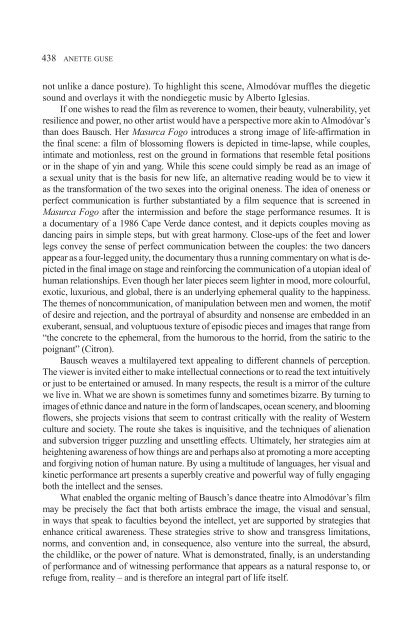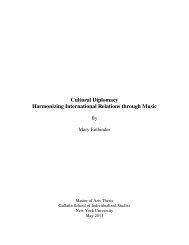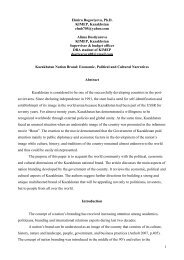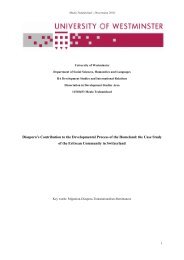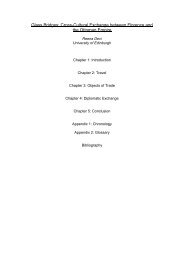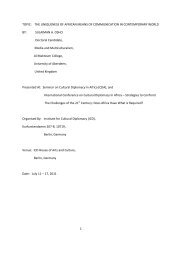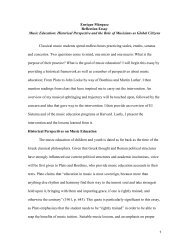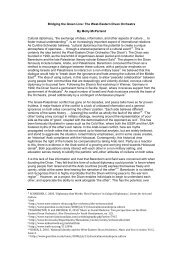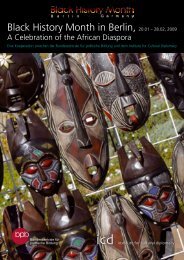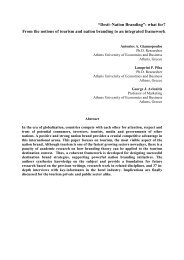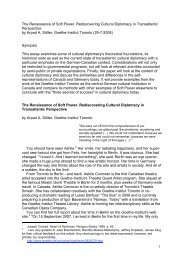Hable con ella - Institute for Cultural Diplomacy
Hable con ella - Institute for Cultural Diplomacy
Hable con ella - Institute for Cultural Diplomacy
Create successful ePaper yourself
Turn your PDF publications into a flip-book with our unique Google optimized e-Paper software.
438 ANETTE GUSE<br />
not unlike a dance posture). To highlight this scene, Almodóvar muffles the diegetic<br />
sound and overlays it with the nondiegetic music by Alberto Iglesias.<br />
If one wishes to read the film as reverence to women, their beauty, vulnerability, yet<br />
resilience and power, no other artist would have a perspective more akin to Almodóvar’s<br />
than does Bausch. Her Masurca Fogo introduces a strong image of life-affirmation in<br />
the final scene: a film of blossoming flowers is depicted in time-lapse, while couples,<br />
intimate and motionless, rest on the ground in <strong>for</strong>mations that resemble fetal positions<br />
or in the shape of yin and yang. While this scene could simply be read as an image of<br />
a sexual unity that is the basis <strong>for</strong> new life, an alternative reading would be to view it<br />
as the trans<strong>for</strong>mation of the two sexes into the original oneness. The idea of oneness or<br />
perfect communication is further substantiated by a film sequence that is screened in<br />
Masurca Fogo after the intermission and be<strong>for</strong>e the stage per<strong>for</strong>mance resumes. It is<br />
a documentary of a 1986 Cape Verde dance <strong>con</strong>test, and it depicts couples moving as<br />
dancing pairs in simple steps, but with great harmony. Close-ups of the feet and lower<br />
legs <strong>con</strong>vey the sense of perfect communication between the couples: the two dancers<br />
appear as a four-legged unity, the documentary thus a running commentary on what is depicted<br />
in the final image on stage and rein<strong>for</strong>cing the communication of a utopian ideal of<br />
human relationships. Even though her later pieces seem lighter in mood, more colourful,<br />
exotic, luxurious, and global, there is an underlying ephemeral quality to the happiness.<br />
The themes of noncommunication, of manipulation between men and women, the motif<br />
of desire and rejection, and the portrayal of absurdity and nonsense are embedded in an<br />
exuberant, sensual, and voluptuous texture of episodic pieces and images that range from<br />
“the <strong>con</strong>crete to the ephemeral, from the humorous to the horrid, from the satiric to the<br />
poignant” (Citron).<br />
Bausch weaves a multilayered text appealing to different channels of perception.<br />
The viewer is invited either to make intellectual <strong>con</strong>nections or to read the text intuitively<br />
or just to be entertained or amused. In many respects, the result is a mirror of the culture<br />
we live in. What we are shown is sometimes funny and sometimes bizarre. By turning to<br />
images of ethnic dance and nature in the <strong>for</strong>m of landscapes, ocean scenery, and blooming<br />
flowers, she projects visions that seem to <strong>con</strong>trast critically with the reality of Western<br />
culture and society. The route she takes is inquisitive, and the techniques of alienation<br />
and subversion trigger puzzling and unsettling effects. Ultimately, her strategies aim at<br />
heightening awareness of how things are and perhaps also at promoting a more accepting<br />
and <strong>for</strong>giving notion of human nature. By using a multitude of languages, her visual and<br />
kinetic per<strong>for</strong>mance art presents a superbly creative and powerful way of fully engaging<br />
both the intellect and the senses.<br />
What enabled the organic melting of Bausch’s dance theatre into Almodóvar’s film<br />
may be precisely the fact that both artists embrace the image, the visual and sensual,<br />
in ways that speak to faculties beyond the intellect, yet are supported by strategies that<br />
enhance critical awareness. These strategies strive to show and transgress limitations,<br />
norms, and <strong>con</strong>vention and, in <strong>con</strong>sequence, also venture into the surreal, the absurd,<br />
the childlike, or the power of nature. What is demonstrated, finally, is an understanding<br />
of per<strong>for</strong>mance and of witnessing per<strong>for</strong>mance that appears as a natural response to, or<br />
refuge from, reality – and is there<strong>for</strong>e an integral part of life itself.


